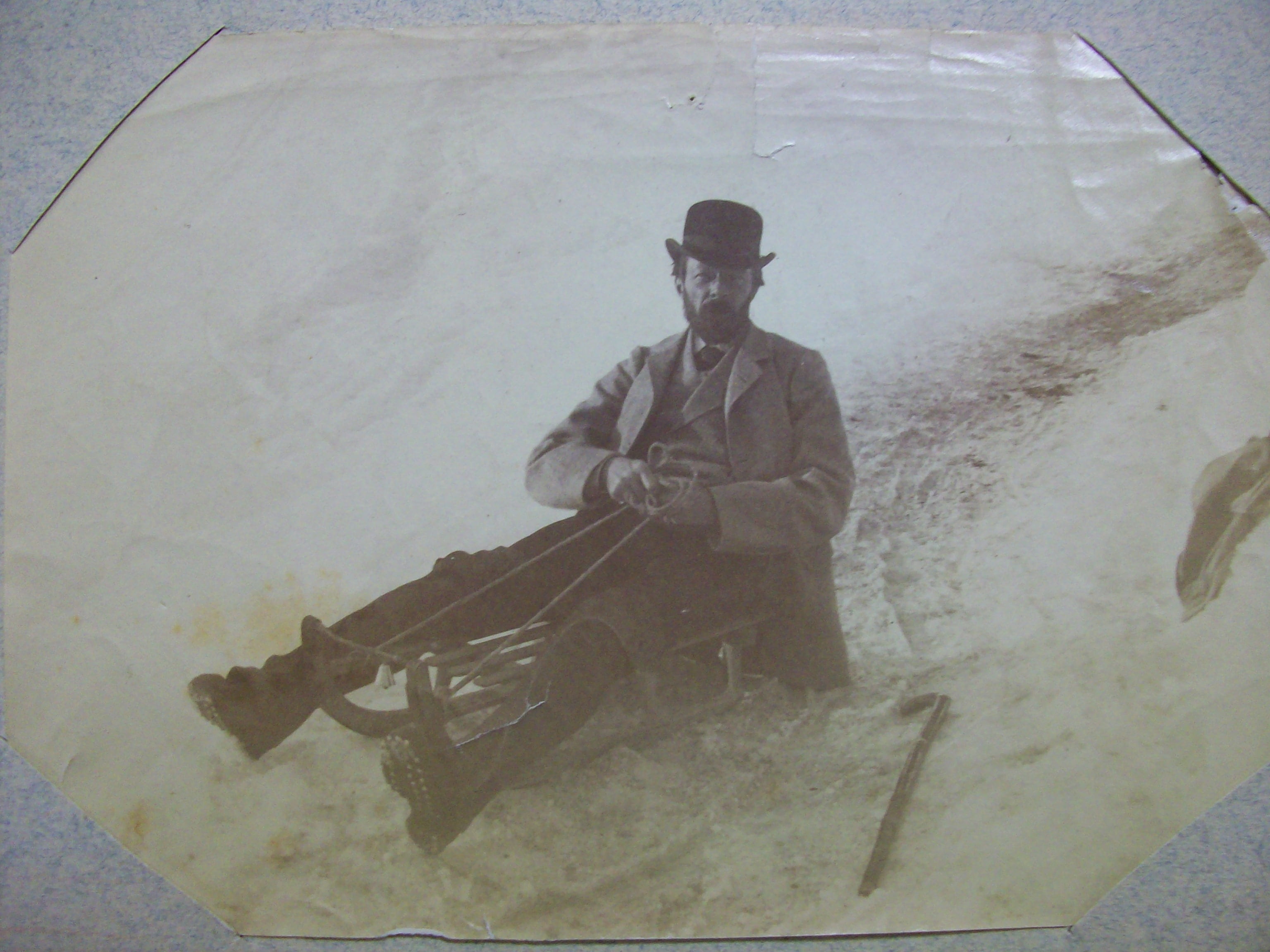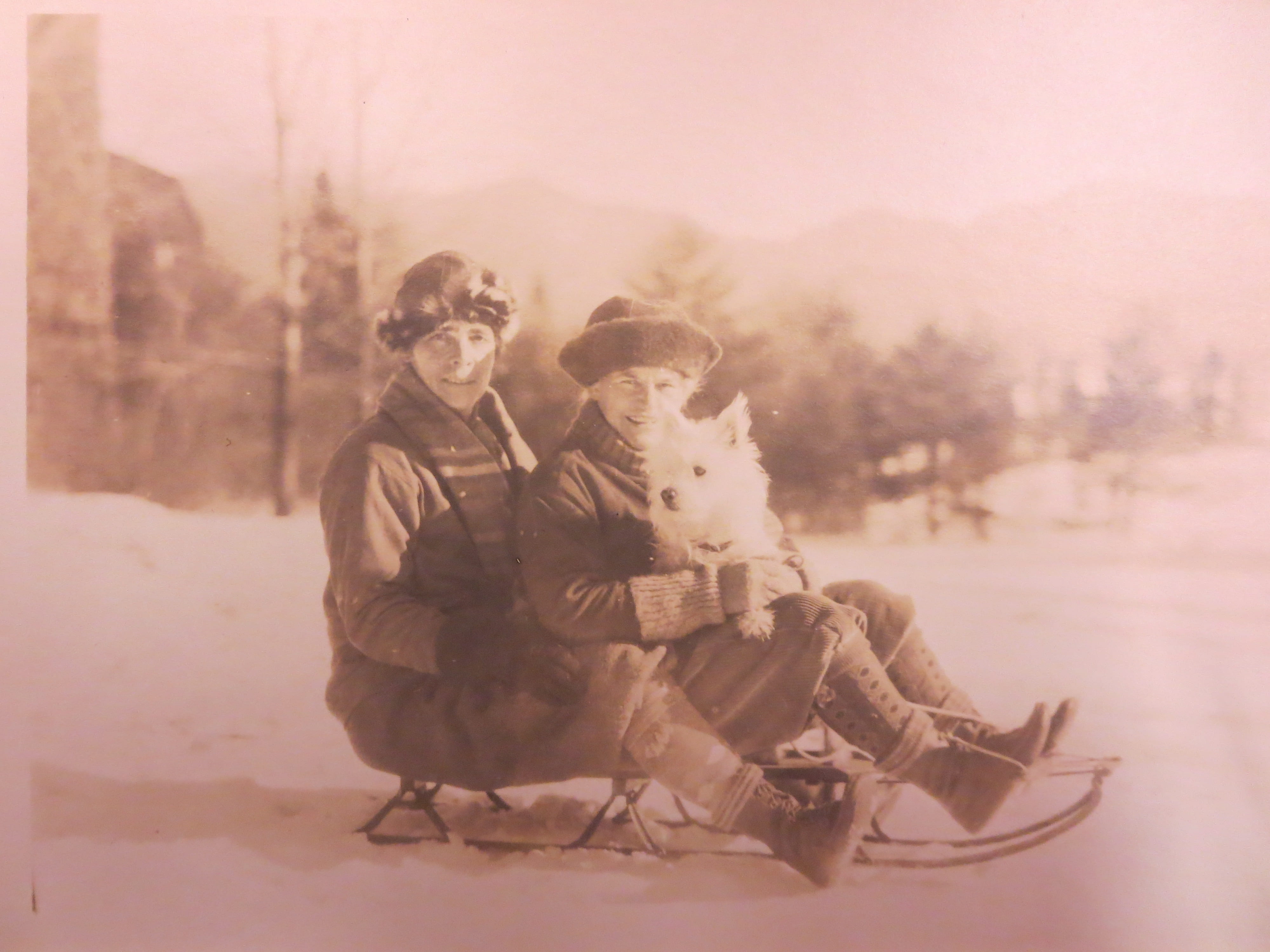by Emily Rutherford
For the sake of some midweek levity, and in honor of the weather across much of northern North America at the moment, here are some pictures of intellectuals and educators enjoying the snow:

J.A. Symonds tobogganing in Davos. Bristol University Library, John Addington Symonds Papers, DM 410/2 (Emily Rutherford)

Virginia Gildersleeve, Caroline Spurgeon, and dog tobogganing. Columbia University Rare Books and Manuscript Library, Virginia Gildersleeve Papers, Box 5 (Emily Rutherford)
As comical as these pictures are, there’s actually something to be said here about the culture in which an increasingly professionalized group of Anglo-American intellectuals operated. Sports such as rugby, American football, baseball, and rowing loomed large in schools and universities on both sides of the Atlantic, and the history of universities and of institutions like the Rhodes Scholarships tells us lots about the racialized valences of this. But that’s not the whole story: among university men in England—even those who weren’t particularly athletic or oriented toward a “muscular Christian” attitude—Alpine adventuring and other winter sports were particularly trendy in the latter decades of the nineteenth century. In January 1884, the Oxford Magazine satirically commented on the fad for mountain-climbing by suggesting, “It is proposed to utilise Port Meadow [a large tract of common land in Oxford] by importing and erecting upon it a genuine Alp, to be selected by the Oxford members of the Alpine Club, from whose number a Reader in Alpine Climbing might be appointed” (vol. 2 issue 1, 19 (Bodleian Library)). Long-distance walking was also popular, as Arthur Sidgwick’s diaries show: Sidgwick records astonishingly long walking trips across England, such as from Oxford to Windsor, a distance of almost fifty miles on present-day roads. But the Alps loomed particularly large in the culture in which most of the middle-class British people connected to education and ideas in this period operated: they had the disposable income for holidays and the knowledge of French and German, and groups of young men or nuclear family units often holidayed in the Swiss Alps. John Addington Symonds (top picture) met his wife there while on holiday with a group of friends (she, also English, was on holiday with her family); later, having contracted tuberculosis, he and his family moved permanently to Davos, site of a primarily anglophone health resort for people with respiratory illnesses. The whole Symonds family became heavily involved in winter sports, and while this reflected something about the English culture to which they belonged, it also may have helped the family to move beyond their English enclave. Symonds’ daughters Margaret and Katherine both record in memoirs about their childhood in Davos that through winter sports they interacted with local children of different class backgrounds, while Symonds père was celebrated in the local community for sponsoring an annual toboggan race.
It’s not wildly implausible that the Symonds daughters’ enthusiasm for winter sports might have rubbed off on other educated women of their generation involved in internationalist charitable causes, as they were. There’s no way of knowing this, but the bottom picture depicts two women of the same age who moved in a similar orbit: Virginia Gildersleeve, Dean of Barnard College from 1911 through the Second World War, and Caroline Spurgeon, a professor of medieval literature at Bedford College, London, who were long-term romantic partners. I don’t know where or when this photograph was taken, but I found it in a folder of other photographs and memorabilia that document Spurgeon’s and Gildersleeve’s relationship. Due to being lost among Gildersleeve’s papers for some years, this one file escaped the flames to which most of the couple’s letters and so on were consigned. With the dog, it’s very much a family group, and it evokes something about what William Whyte has called intellectuals’ “lives beyond their books” (18).
In the same article, Whyte also asks us to consider “the way in which walking, and cycling, rowing and mountaineering became the characteristic—and self-consciously characteristic—occupations of the intellectual aristocracy” (35). Whatever one might think about the usefulness of the label “intellectual aristocracy,” I think this is true of this group of British professional intellectuals and their families, and it seems to transcend strict gender lines or religious, political, and imperial ideologies. I’m not entirely sure what to make of this—if you have some ideas, I hope you’ll share them in the comments! But it’s a useful and evocative reminder that intellectuals are people—with significant relationships, children, health concerns, and even hobbies—as much as they are generators of ideas.




February 4, 2015 at 1:55 pm
This fascinating post reminds me of the friend, a female member of a proconsular family, who told me that her brothers’ motto, in the Alps, was “No Greek above the snow line.” But it also reminds me of my Renaissance humanists–e.g. Leon Battista Alberti, who, we are told [admittedly by him, writing in the third person], made an art out of walking, conversing and riding, and could jump over a man standing next to him and throw a coin so high that it rang when it struck the ceiling of the Duomo. Symonds, of course, was far from the only one in his time to feel an elective affinity with his Renaissance counterparts . . .
February 4, 2015 at 7:14 pm
Awesome, thanks for these thoughts! I imagine Hellenism also has to loom pretty large in what these guys saw as the genealogy of their athletic pursuits: for Symonds, to whom Davos seems to have offered many of the, err, visual delights of the palaestra, and perhaps for others too.
There’s also the point that only just occurred to me that the pursuits Whyte identifies as particularly associated with the intelligentsia (walking, cycling, rowing, mountaineering) also offer fairly good prospects for conversation during. Not so much the case for rugby or American football!
February 4, 2015 at 7:26 pm
Also just wanted to add that as citing archival sources on a blog can get unwieldly, I haven’t cited every bit of information from my own research I drew upon in writing this. Please contact me (or just comment here) if you’d like some footnotes!
February 5, 2015 at 10:01 am
Let’s not forget Pattison’s favorite forms of exercise: croquet of a strenuous kind and lawn tennis. One might also recall that favorite form of walk: reopening historical rights of way across actively farmed land and being chased by farmers, dogs and bulls (still in vogue when a friend of ours was a Cambridge JRF in the Fifties). Conversation must have been intermittent. Commensality on the grand 19th century scale might also have played a role, at least in necessitating all that toboggan riding.
February 5, 2015 at 9:09 pm
Having been chased by cattle on historical right-of-ways through farmland I can attest that country walking is not without its adrenaline rushes. I suspect Symonds was more into Alpine healthfulness, but excessive formal dinners certainly loomed as large in Oxbridge circles as they do today. It’s interesting to think there might be a connection!
February 20, 2015 at 4:06 pm
Readers might be interested to learn, as I just did, that Karl Pearson, the founder of the radical 1880s London discussion group the Men’s and Women’s Club, likened sex for pleasure to “mountain climbing with a friend.”